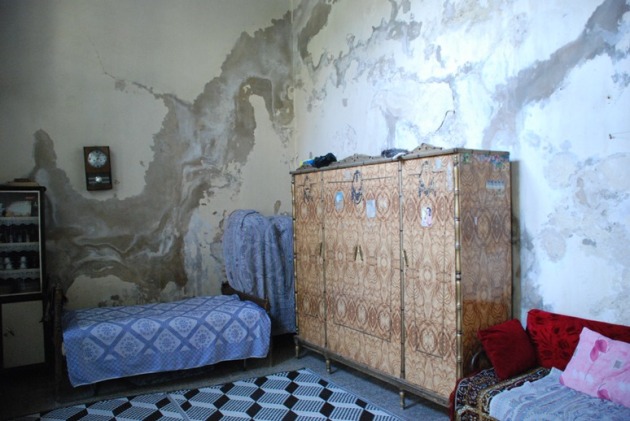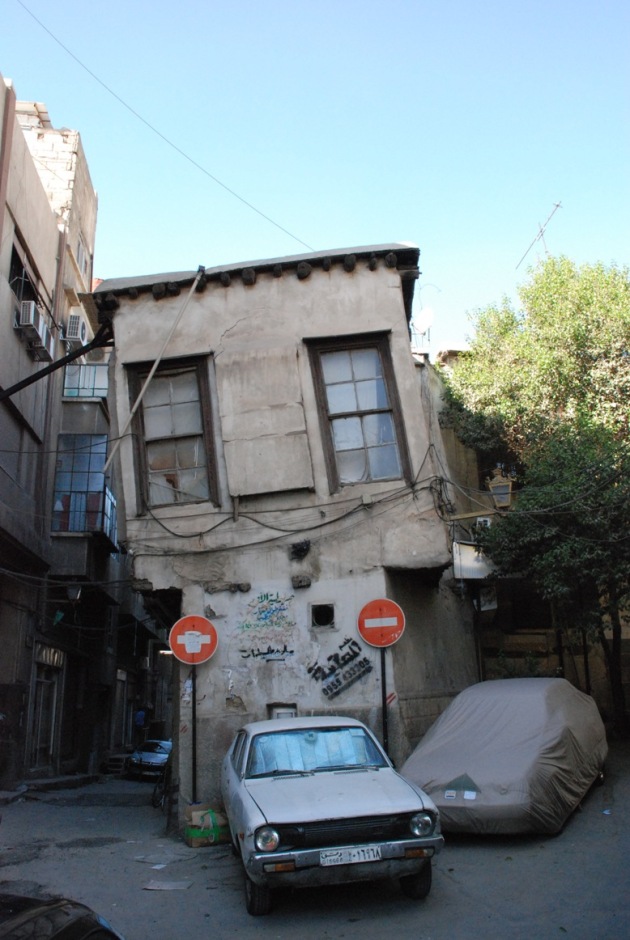How do you preserve one of the oldest cities on earth without transforming it into a noisy tourist zone? I went with Francesca de Chatel to meet some of the developers, planners and conservationists who are trying to save the Old City of Damascus.
Like stepping into a scene from Arabian Nights – that’s what it’s like when you walk into the Talisman, one of Syria’s first five-star boutique hotels. Housed in an old palace in Damascus’ Jewish Quarter, it has 16 ornately decorated rooms and suites and two passion-red courtyards overflowing with jasmine, roses and fruit trees. However, a brief visit to the Dabaan house just next door will bring you back down to earth with a brutal jolt: the family of seven also lives in a traditional Damascene house, but every night Fatima Dabaan and her relatives go to bed fearing the ceiling may fall on their heads as they sleep. Centred around a small courtyard, the two-storey house has six rooms, of which only one is still in use. In the others, the wood-and-earth ceiling has started to sag ominously, while large patches of mould and humidity draw intricate patterns on the walls.
“This used to be the living room, but we had to clear it out, because the external wall is caving in and the ceiling is falling down,” says Mrs. Dabaan, a widowed mother of two. She explains that the upstairs rooms are completely inaccessible as the floor is not safe to walk on, and that even in the only room they still use, the ceiling is slowly giving way. The Dabaan family, who live off SYP 6,000 (USD 126) a month, have been tenants in the house for the last 50 years and have watched it gradually fall apart without being able afford restoration or maintenance. “The municipality keeps promising that it will send someone to fix things, but they never come,” she sighs helplessly. “And now that winter is coming I really don’t know what we are going to do.”
The stark contrast between the crumbling Dabaan family home and the luxurious Talisman Hotel around the corner is a consequence of nearly seven years of uncontrolled real estate development in the Old City. Since the late 1990s, more than 90 hotels and restaurants have sprung up, profoundly changing the character of city’s old quarters and gradually driving local residents out of the neighbourhood. Many of those who have stayed complain that the many new eateries are an infringement on their privacy: they say locals today feel like strangers in their own neighbourhood and that their streets have been turned into busy thoroughfares filled with strangers. “Certain parts of old Damascus have become overcrowded and noisy day and night,” Maher Salma, a resident of Qaymarieh says.

In the Dabaan house, the wood-and-earth ceiling has started to sag ominously, while large patches of mould and humidity draw intricate patterns on the walls.
Entertainment zone
Architect and heritage expert Luna Rajab explains that while the changes have only become apparent in the last few years, the movement was already initiated in the 1950s when people started leaving the Old City and seeking more modern accommodation in the new city. Their former homes were either abandoned or used as storage spaces and rapidly deteriorated. Others were let out to tenants who often could not afford – and also often didn’t care – to restore the house. At length many of them put their houses on sale, and the investors who bought them found that the only way to restore them was to open them up to commercial activity.
Beit Jabri owner Raed Jabri was the first to open a restaurant in the Old City in the 1990s. Unlike most other restaurant owners, Jabri has a close personal connection to the old house that is today a popular restaurant near the Omayyad Mosque: he grew up in it and it has been in his family for generations. After he left home though, the house was gradually abandoned by the rest of the family and rapidly fell into disrepair. Jabri decided to save the house, and soon realised that the only way he would be able to afford that would be to open a small café in the courtyard. The café soon became a restaurant, and Jabri was able to restore his family home step by step.
“What makes Beit Jabri different, is that I didn’t start off with a business idea or with the aim of getting rich out of this. All I wanted is for people to be able to come from the street and see how beautiful this house is,” he comments.
Since Beit Jabri opened its doors in 2001, 85 other restaurants and cafés have sprung up in the alley ways of the old town. A further 25 have obtained licenses and are soon to open. In addition, 30 hotels have obtained licenses. “Giving restaurant and hotel licenses is the only way to restore the houses,” Amjad Arz, the director of the Old City, says. “People can’t afford to restore and banks don’t give house loans to Old City residents.”
The development of so many new restaurants and hotels worries not only locals but also conservation experts. “I’m not against restaurants and hotels in principal,” Rajab says. “But I am against turning the whole city into an entertainment zone. The development is making the city lose its identity.”
To address the issue of uncontrolled development and help preserve the character of the Old City, the municipality has outlined an urban master plan for the area within the city walls which includes restrictions on the further development of restaurants. Arz explains that the Old City has been divided into different zones, with three “restaurant areas” in Qaymarieh, Bab Tuma and Midhat Pasha. Other neighbourhoods are reserved for residential use and small hotels. Working in cooperation with the EU-funded Municipal Administration Modernisation (MAM) project, the Directorate of the Old City also aims to improve conditions for local residents with new job opportunities and financial assistance to restore homes.
The plan includes creating better job opportunities to encourage people to stay in the Old City area. “We can’t consider any kind of industry,” says Erfan Ali, the MAM programme director. “Instead we want to focus on traditional sectors like handicrafts, textiles and small industry, and also tourism.”
Ali explains that tourism development is an important component of the master plan and that, if carried out correctly and according to certain restrictive guidelines, it can benefit both the Old City and its residents.
“We want to keep local shops and workshops in the Old City, we want to keep mosques, churches and monuments and preserve them,” he says. “At the same time, Damascus is not a dead city – it is alive and part of a larger city and region. Most of the shops in the Old City don’t actually serve tourists, they serve locals and Syrians. For example, in the Souq al Souf, you will see hardly any tourists – this is where Syrians from the south come to do their shopping. Tourism is therefore not the only source of income for the Old City.”
The MAM project has also developed a traffic master plan to ban cars from the Old City and introduce a parking system with parking lots outside the city walls. Inside the walls there would be a form of environmentally friendly transport with electric cars and a tramway running around the city walls.
As for home restoration programmes, the Directorate of the Old City has started working with the German technical cooperation programme, GTZ, which recently completed a 13-year project in Aleppo to help low-income residents to restore their homes through a system of small loans and grants.
Project manager Regina Kallmayer says that this housing fund would allow home owners – and possibly tenants too – to apply for loans to carry out minor improvements in their houses. “Things that would make it more attractive for them to stay in their homes, like installing a bathroom or a kitchen, or fixing a wall,” she says.
Applicants would have four years to pay back the interest-free loans and low-income families would receive up to 25 percent of the money as a grant. Kallmayer says that the experience in the Old City of Aleppo was very successful with a low default rate on repayments. “Over the total quota of loans there was between 2 and 5 percent loss. This was mainly the case in families where the main breadwinner suddenly died or became disabled,” she says, adding that she sees great potential in the Old City of Damascus.
Between the Directorate of the Old City, the MAM project and GTZ, it seems there are plenty of ambitious schemes to rehabilitate, improve and develop the Old City in the coming years. It now remains to be seen how much of the plans will be implemented and whether they will succeed in keeping local residents in the Old City.
However, regardless of all the changes the old city is going through, Jabri believes that the Shami spirit still survives in many small things. “People still go out in their pyjamas to buy bread from the corner bakery, moms still send their kids out in their slippers to go and buy laban from the local shop…”
He said that given that there are now restrictions on the location and number of restaurants, their development is not a bad thing; on the contrary, he believes they have brought a new energy to the city. “Before, the Old City went to sleep at 6pm and there was no one in the street after that. The opening of restaurants has brought new life to the Old City,” he says, adding that the city is evolving together with society.
“The people who come to Beit Jabri today reflect the mosaic of society. We have foreigners and locals; we have muhajaba girls and girls in short sleeves, old and young… What matters in the end is the preservation of Damascus as a city with people. It is the oldest continuously inhabited city in the world and should not be turned into a museum.”
I wrote this article together with Francesca de Chatel for Syria Today magazine.

